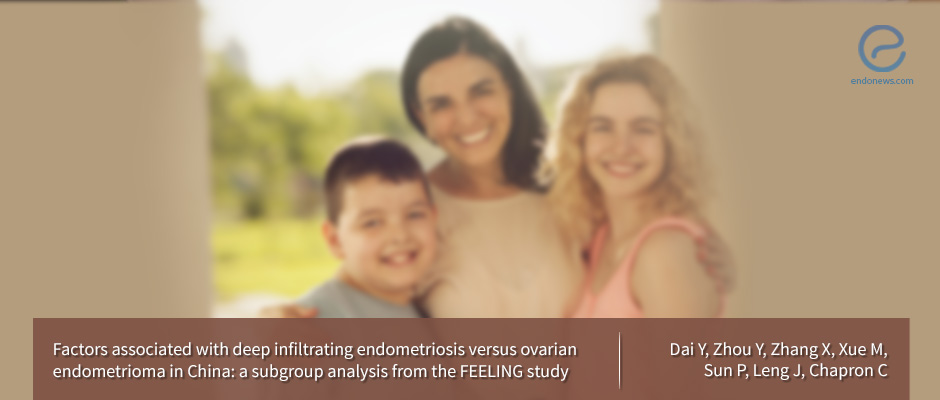Further Results From the FEELING Study Published
Jan 10, 2019
The data provide more information about the potential risk factors associated with deep infiltrating endometriosis.
Key Points
Highlights:
Researchers identified risk factors associated with the development of deep infiltrating endometriosis and ovarian endometrioma.
Importance:
The findings may help better understand deep infiltrating endometriosis, and help group patients according to their risk of developing the condition and therefore reaching an earlier diagnosis, which can speed up the start of treatment and therefore avoid further complications.
What's done here:
Researchers analyzed a subgroup of patients who took part in the FEELING study that aimed to identify potential risk factors linked to the development of severe forms of endometriosis.
Key results:
- Univariate analysis showed that women who were married, were older, had siblings, have had a previous pregnancy or had their first period at a younger age was more likely to be diagnosed with deep infiltrating endometriosis.
- Multivariate analysis showed that women who had siblings, gastrointestinal symptoms during menstruation, or who were eating a greater number of fruit and or vegetables per day were more likely to be diagnosed with deep infiltrating endometriosis, while those eating organic food and experiencing stress were more likely to be diagnosed with ovarian endometrioma.
- Further factors associated with the risk of developing deep infiltrating endometriosis were the incidence of previous uterine surgery, menstrual and ovulatory disorders, painful intercourse, and gastrointestinal symptoms during menstruation.
Limitations:
- The most important limitation of the study is that a causative link cannot be made between the factors associated with the development of endometriosis and actual outcome, i.e. the development of the disease.
- Deep infiltrating endometriosis and ovarian endometrioma often occur simultaneously, making the conditions more complicated to study.
Lay Summary
Some women are more likely to develop deep infiltrating endometriosis according to the further analysis of the results of the FEELING study. These are women who:
- are married,
- are older,
- have siblings,
- have had a prior pregnancy,
- or for whom a long time has passed since their first period on the day of their visit
“The findings provide additional information on the potential risk factors that are associated with [deep infiltrating endometriosis]” the researchers wrote. They added that the results may also help to better understand deep infiltrating endometriosis and aid in earlier risk stratification and diagnosis of the patients.
The aim of the FEELING study was to identify genetic, medical, dietary, and environmental factors that may be associated with the development of endometrioma and/or deep infiltrating endometriosis. The identification of such factors could help with early diagnosis and the implementation of potential measures to prevent the development or progression of the condition.
It enrolled more than 1,000 participants, ages 18 to 41 in China, France, and the Russian Federation. The participants had all undergone laparoscopy or laparotomy for a benign gynecological condition in the three months prior to enrolment. Only participants who showed no visible endometriosis lesions or histologically confirmed endometriosis lesions such as superficial endometriosis, endometrioma, or deep infiltrating endometriosis were included in the study.
Researchers then identified factors associated with endometrioma and/or deep infiltrating endometriosis using retrospective data collection and a patient questionnaire.
In the present study, which was published in the scientific journal BMC Women’s Health, researchers analyzed a subgroup of participants, 158 of whom had then been diagnosed with ovarian endometrioma and 78 with deep infiltrating endometriosis.
Using statistical analyses, the researchers found that apart from the factors mentioned above, other factors that were significantly associated with a diagnosis of deep infiltrating endometriosis included:
- a previous uterine surgery,
- menstrual and ovulatory disorders,
- pain during intercourse,
- and gastrointestinal symptoms during menstruation
Moreover, multivariate analysis showed that women who had siblings, gastrointestinal symptoms during menstruation, or those eating a greater number of fruit and or vegetables per day were more likely to be diagnosed with deep infiltrating endometriosis. On the other hand, women who were eating organic food and experiencing stress were more likely to be diagnosed with ovarian endometrioma.
It is important to note that the statistical analyses in this study are only able to find a correlation between several factors and the development of endometriosis or other related conditions and that they do not constitute a causative link between those factors and the development of the condition. In other words, it is not possible to conclude from the results that eating fruit does cause endometriosis, as having siblings cannot cause the condition. Instead, they are only risk factors and could help doctors monitor more closely women who for example have gastrointestinal symptoms during menstruation due to their potential risk of developing deep infiltrating endometriosis.
Research Source: https://www.ncbi.nlm.nih.gov/pubmed/30577792
risk factors deep infiltrating endometriosis ovarian endometrioma clinical trial Chinese women; Deep infiltrating endometriosis (DIE); FEELING study; Ovarian endometrioma (OMA)

